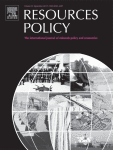
Publication de l’article “Long-term availability of global uranium resources Author links open overlay panel” par Antoine Monnet, Sophie Gabriel et Jacques Percebois dans la revue Resources Policy.
Volume 53, September 2017, Pages 394-407
https://doi.org/10.1016/j.resourpol.2017.07.008
Résumé:
Against a backdrop of decarbonisation in the energy sector and the increasing share of nuclear power in the global power mix, availability of uranium resources presents a major challenge. Since it will be some time before technologies of future nuclear reactors which remove the reliance on natural uranium are fully deployed, it is relevant to analyse the availability conditions for uranium in the 21st century. The first two conditions – technical accessibility and economic value – are associated with production cost. We study these by modelling the ultimate uranium resources (including both identified and undiscovered resources) and their cost. This method is based on a regional breakdown of global uranium resources, current known deposits and an economic filter. It allows us to establish a long-term supply curve in which the quantities of technically accessible uranium resources are represented as a function of production cost. The other uranium availability conditions considered are associated with market dynamics, which created by the relationship between supply and demand. These are modelled in the form of dynamic constraints in a partial equilibrium market model. This is a deterministic model in which the market players are represented by regions. It allows us to take account, for instance, of the short-term correlation between price and exploration expenditure. In the longer term, the constraints modelled include anticipation of demand from electric utilities (the consumers) and the increasing scarcity of the least costly ultimate resources. Using a series of forward looking simulations, we demonstrate that the rate of growth in demand for uranium in the 21st century and its anticipation have a major impact on the increase in price in the long-term. Conversely, uncertainties related to the estimation of ultimate resources have a limited effect. Lastly, some variations in supply (uranium prouction shutdown in a particular region, for example) or demand (irregular increase) also have a significant impact on long-term price trends or cycles.
Retrouvez l’article ici
